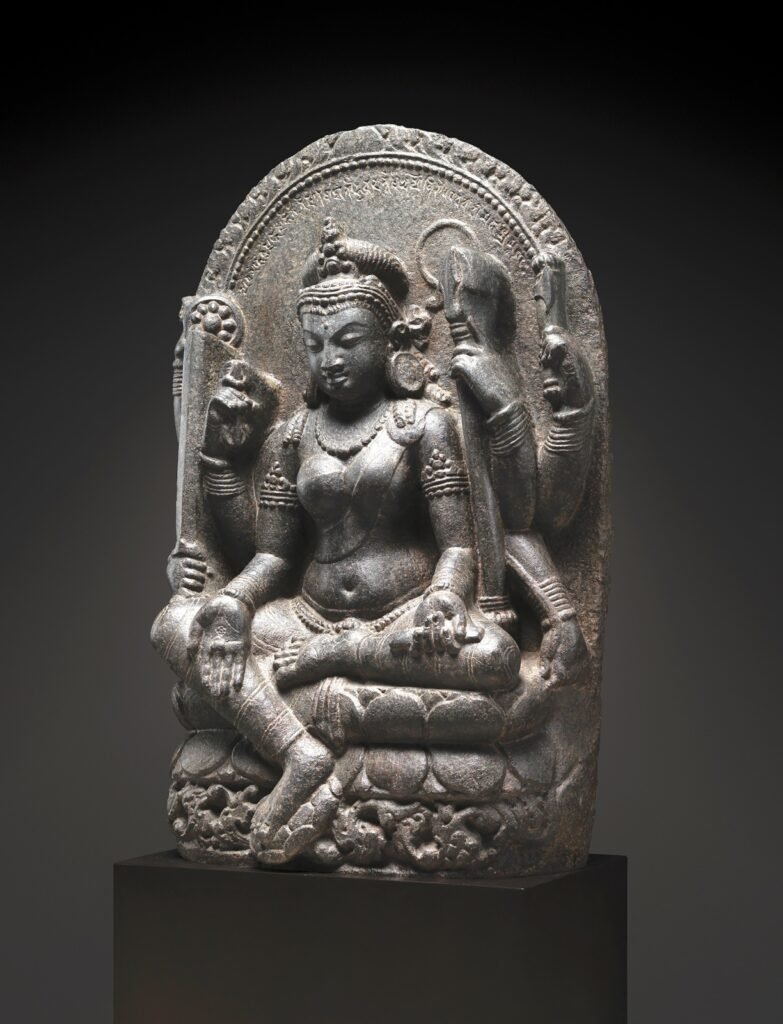Introduction
In the vast and intricate world of Buddhism, certain figures stand out as symbols of protection, wisdom, and compassion. One such figure is mhâpratisarâ a revered deity in Mahāyāna and Vajrayāna traditions. Often depicted as a multi-armed goddess, she embodies the protective power of sacred mantras and serves as a guardian against negative forces. This article delves into the life, significance, and practices associated with Mahāpratisarā, offering insights into her role in Buddhist spirituality.
🕉️ Who is Mahāpratisarā?
Mahāpratisarā, whose name translates to “Great Amulet” or “Great Wish-Fulfiller,” is a prominent deity in East Asian Buddhism. She is considered an emanation of Ratnasambhava, one of the Five Wisdom Buddhas, and is often depicted as a protector goddess. In various traditions, she is associated with the Pañcarakṣā, a group of five protective deities, and is revered for her ability to safeguard practitioners from harm and misfortune.
🛡️ The Role of Mahāpratisarā in Buddhist Practice
In Buddhist practice, Mahāpratisarā is invoked through the recitation of her dhāraṇī—a type of mantra believed to possess protective and purifying qualities. Devotees often inscribe this dhāraṇī on amulets, banners, or walls to invite her blessings and protection into their lives. The dhāraṇī is also recited during rituals and ceremonies to invoke her presence and assistance.
🎨 Iconography and Symbolism
Mahāpratisarā is typically depicted with multiple arms, each holding a different symbolic object. These objects represent various aspects of protection and spiritual power. Common attributes include:
- Vajra (thunderbolt): Symbolizing indestructible power.
- Sword: Representing the cutting of ignorance.
- Bow and arrow: Signifying the precision of wisdom.
- Noose: Used to bind negative forces.
- Axe: Cutting through obstacles.
- Wheel (cakra): Representing the Dharma wheel.
Her multi-armed form signifies her ability to protect from all directions and aspects of life.
🌍 Mahāpratisarā Across Cultures
While Mahāpratisarā’s origins are rooted in Indian Buddhism, her worship spread across Asia, adapting to various cultural contexts:
- China: Known as Dàsuíqiú (大随求菩萨), Mahāpratisarā is venerated in Chinese Esoteric Buddhism. Her dhāraṇī is often inscribed on amulets and used in protective rituals.
- Japan: In Japanese Buddhism, she is referred to as Daizuiku Bosatsu (大随求菩薩) and is depicted in mandalas and ritual texts.
- Tibet: Mahāpratisarā is recognized as a protector deity and is included in Tibetan Buddhist rituals and practices.
🧘♀️ Practices Associated with Mahāpratisarā
Devotees engage in various practices to invoke Mahāpratisarā’s protection and blessings:
- Recitation of the Dhāraṇī: Chanting her dhāraṇī is believed to purify negative karma and protect against misfortune.
- Inscription on Amulets: Writing her dhāraṇī on paper or metal and wearing it as an amulet is a common practice.
- Ritual Offerings: Offering incense, flowers, and light during ceremonies dedicated to Mahāpratisarā.
- Meditation: Contemplating her form and attributes to internalize her protective qualities.
🏛️ Mahāpratisarā in Art and Architecture
Mahāpratisarā’s influence is evident in Buddhist art and architecture. Sculptures and paintings often depict her with multiple arms and various symbolic objects. In some traditions, she is shown seated on a lotus, surrounded by flames, symbolizing her power to dispel ignorance and evil. Her image is commonly found in temples, shrines, and sacred texts across Asia.
📚 The Pañcarakṣā and Mahāpratisarā
The Pañcarakṣā is a collection of five protective texts, each associated with a different deity. Mahāpratisarā is the central figure in this group, and her dhāraṇī is considered the most powerful. The other four deities in the Pañcarakṣā are:
- Mahāmāyūrī: The peacock goddess, symbolizing protection from poisons.
- Mahāśītavatī: The goddess of wealth and prosperity.
- Mantramanudharanī: The goddess of mantra and spiritual power.
- Mahāpratisarā: The central protector, embodying the power of all mantras.
Together, these deities offer comprehensive protection in various aspects of life.
🧧 Mahāpratisarā in Rituals and Ceremonies
In Buddhist rituals, Mahāpratisarā’s dhāraṇī is recited to invoke her protection and blessings. These rituals may include:
- Homa Ceremonies: Fire rituals where offerings are made to deities.
- Protective Rituals: Ceremonies aimed at dispelling negative influences and ensuring safety.
- Healing Rituals: Invoking Mahāpratisarā’s blessings for physical and spiritual healing.
These ceremonies are performed by monks, nuns, and lay practitioners alike.
🌟 The Significance of Mahāpratisarā Today
In contemporary times, Mahāpratisarā continues to be a source of inspiration and protection for many Buddhists. Her teachings emphasize the power of sacred words and the importance of spiritual protection. In a world filled with challenges and uncertainties, her presence offers solace and guidance.
🧭 Conclusion
Mahāpratisarā stands as a beacon of protection, wisdom, and compassion in the Buddhist tradition. Through her dhāraṇī and symbolic representation, she reminds practitioners of the power of sacred words and the importance of spiritual guardianship. Whether through recitation, meditation, or ritual, invoking Mahāpratisarā offers a path to inner peace and protection from life’s adversities.
❓ Frequently Asked Questions (FAQs)
1. Who is Mahāpratisarā?
Mahāpratisarā is a female deity in Mahāyāna and Vajrayāna Buddhism, known as the “Great Amulet” or “Great Wish-Fulfiller.” She serves as a protector and is associated with the Pañcarakṣā, a group of five protective deities.
2. What is the Pañcarakṣā?
The Pañcarakṣā is a collection of five protective texts, each associated with a different deity. Mahāpratisarā is the central figure, and her dhāraṇī is considered the most powerful.
3. How is Mahāpratisarā depicted in art?
Mahāpratisarā is typically depicted with multiple arms, each holding a different symbolic object such as a vajra, sword, bow, or noose. These attributes represent various aspects of protection and spiritual power.
4. What is a dhāraṇī?
A dhāraṇī is a type of mantra believed to possess protective and purifying qualities. Devotees recite Mahāpratisarā’s dhāraṇī to invoke her blessings and protection.
5. How can I practice invoking Mahāpratisarā?
Practices include reciting her dhāraṇī, inscribing it on amulets, offering incense during rituals, and meditating on her form and attributes to internalize her protective qualities.
